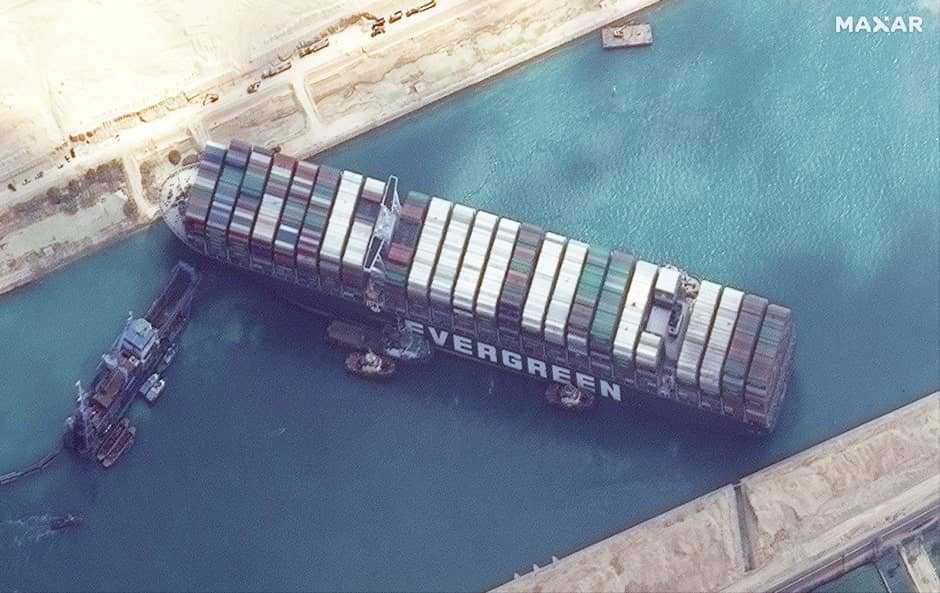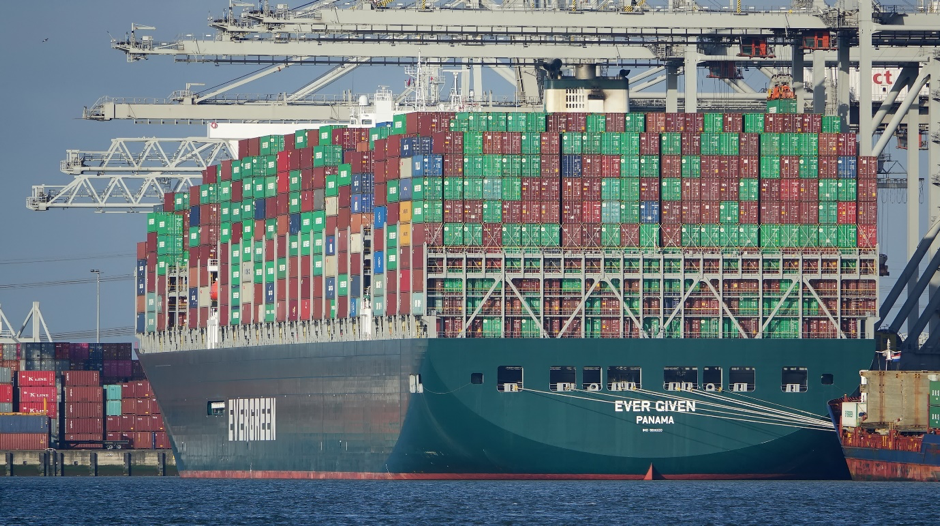Despite significant dredging and tugging to free the vessel, the blockage is still there. We expect this to cause huge disruptions to global trade and increased shipping rates, so be prepared for delays in your shipments.
How did the Suez Canal blockage happen?
We don’t know the precise cause yet. The Japanese-owned Ever Given, holding about 20,000 containers,entered the canal from the Red Sea and only ran aground approximately 45 minutes later.
Over 50 ships pass through the canal every day, so it’s important the exact cause is determined. We expect investigations to take their course and shed light on how this could happen to the vessel nearly the size of the Empire State Building.

The Taiwan-based operator, Evergreen, blamed strong winds. They reported a sandstorm overtaking the area with winds travelling speeds of up to 50 kilometres per hour.
But a range of factors could have played a role. There may have been unexpected exposure to natural elements, but also a potential loss of power or problems with steering. Basic human error may also be at play, given that many large ships have passed through the canal without incident.
The sheer size of the vessel itself – the Ever Given being one the of the largest container vessels in the world – means it faced an inherent increased risk of running aground.
When will the blockage be fixed?
Very hard to say.
The vessel cannot simply reverse out like a truck. It’s firmly wedged into the Suez Canal’s banks, so it needs to be refloated before it can go anywhere. Nor can you simply ‘unpack’ the ship (being full of extremely heavy cargo).
Digging the vessel out of the ground could take a few days. Authorities need to remove the sand and mud wedging the ship into the banks. Once it’s finally out, it will likely reverse out the way it came.
Will the blockage cause shipping delays?
Yes.
According to Lloyd’s List, the blockage is causing delays worth $400 million an hour. There are also reports of ships in the canal stuck in ‘traffic jams’ just waiting for the blockage to clear.
Many vessels are now even considering travelling around Africa via the Cape of Good Hope (adding around two weeks to their journey).

The Ever Given is one of the largest container ships in the world
But whether you, as an importer, feel the delay will depend on where you’re based.
The canal, being 190 kilometres long and a passageway for around 12% of the world’s ocean trade, is one of the most important shipping routes from Europe into the Indian and Pacific Oceans. Nearly $9.6 billion worth of goods enter through the canal each day, and about a quarter of the traffic is on container vessels.
Most of the ships that pass through the canal are container ships, but there are also tankers, bulk carriers, general cargo vessels, car carriers, RORO and LNG ships.
The global supply chain is already facing an unprecedented amount of pressure. A rapid pandemic-driven increase in demand for cargo and port congestion has already caused delays with vessels unable to dock and unload their goods.
Countries like the United States and Australia, who receive most of their goods from Asia, will be less directly impacted in the short-term compared to those importers in Europe. But the blockage will also halt empty containers returning to Asia which will only exacerbate the global container shortage.
Consumers will likely feel an impact if the blockage goes on for much longer. This is especially the case for goods that are assembled in Europe before being shipped to other countries such as the United States. European economies who import car parts will also experience the brunt of these delays.
We expect delays in oil shipments, as just under 2 million barrels of oil flows through the Suez each day (approximately 7% of all ocean-borne oil). We also expect delays in refined petroleum products on their way to Europe, like jet fuel and gasoline.
Delays through the canal will likely also increase the risk of congestion at ports, especially in Europe. This is because delayed cargo will arrive at the same time as the cargo scheduled to arrive on time – congestion means more delays, as ships will have to wait to unload their containers.
If the blockage is resolved soon, delays will be minimal. But the longer this drags on, the increased risk of delays in more parts of the world (including Australia and the United States) will materialise.
Will shipping rates increase because of this?
We expect so.
This will be troublesome news for importers, with shipping costs already being very high.
Shipping rates for oil have already doubled. This is not surprising, given vessels need to reroute their cargo and burn more fuel – accounting for 60% of a ship’s operating costs.

The index for Large Range 2 tanker vessels from the Middle East to Japan has also already escalated to 137.5 worldscale points on Friday 26 March, compared with 100 worldscale points the previous week.
We’re expecting an increase in spot freight rates, and so are some of the banks. Both JP Morgan and the Bank of America predict increased bunker costs due to the requirement to reroute. The Freightos Baltic Index (FBX) has already recorded a 13% increase in spot rates from Asia to the west coast of the United States.
The blockage is already having an impact on the price of oil. Oil prices rose by around 3 per cent on Friday 26 March, but the impact will probably be temporary.
Delays to your shipment – how to prepare
Many importers around the world are already experiencing delays to their shipment because of the COVID-19 impact on their supply chains.
Nevertheless, we’ve outlined some tips for your business to deal with setbacks arising from the blockage in the Suez Canal:
1. Let your customers know – explain why there might be a delay in their shipment.
2. Offer free shipping – your customers will have lower expectations and won’t mind delays if they haven’t paid for shipping.
3. Track your shipment – you and your customers can see where your goods are in real-time, easing the uncertainty.
4. Work with contingency suppliers – use ‘backup’ suppliers (such as domestic suppliers) when international shipments run into problems like this.
Here at The Sourcing Co, our shipping and logistics team can help you prepare for these interruptions.
As a leading sourcing company across the Asia-Pacific, we’ve got the experience and know-how to minimise shipping delays in the event of unforeseen events like the container vessel blocking the Suez Canal.
Please get in touch today to start planning your next shipment.